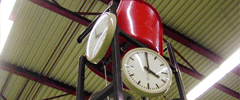First H0-RE meeting in Upphärad, Sweden, 18 – 21 October 2018
Stefan Fjällemark
A successful experiment
In Sweden, FREMO meetings are not the norm, most meetings are arranged by Swedish clubs. So, three FREMO members decided to arrange a second HO-RE-meet ing in addition to the one in Värnamo. The theme was “on Swedish tracks 1967 – 1988”.
In a Swedish module meeting, there are not only FREMO modules, but also many modules built according the Swedish MMM-standard. Add to that a 375 m2 community centre with two small halls, and corridors and you have a layout planners’ nightmare. It was some tough decisions to break the FREMO norm in several places in order to squeeze the layout into the Building.
We managed to build a 160-meter layout, half of it was double track. Some places we used clamps because FREMO- and MMM-profiles don’t have the holes in the same position. We even, god forbid, used some 3R modules wired for 2R operation.
Luckily, many participants have few waggons with strict requirements for FREMO curve and turnout radius, but plenty of stock locos and waggons that worked fine over all the layout.
During the meeting, seven sessions where run. Each session represented a three-year period, first session starting with 1967-1969 and last session ending with 1985-1987. Between sessions, some locos and waggons were replaced, like they did in real during that period.
In order to create an initial cargo flow, we prepared a set of over hundred waybills in advance. We also planned where all the cargo waggons initially should be placed, some of them “halfway” in a switch yard.
Prepared waybills also had printed loading/unloading times that limited which waggons a cargo train could pick up. In addition, module owners could supply waggons with their own waybills.
We also graded driver duties in difficulty 1 – 3, where 3 was trains with lot of shunting. Participants were permitted to jump over an advanced duty if they felt it was over their experience.
The schedule was planned to match the number of expected loco drivers, and special effort was made to spread the duties even over the day and minimize waiting time between duties. This was recognized and appreciated.
One other thing we focused on, was to delegate non-module-owner participant to manage a specific terminus between the sessions. The task was to check that all locos and waggons was in place and prepare departing cargo waggons.
We also knew that the social part of a meeting is important. We got a local supplier of good food and scheduled Saturday evening for socialising. One of the activities was to compete which one having the fastest high-speed train, using the 25 meter straight double track part. This ended as expected, with an accident.
The meeting counted 32 participants ranging from 18 to 75 years old, and with two international representants from Norway and Germany, both speaking Swedish(!)
We also made an evaluation where the participants could give a four-grade answer to a few questions. The result was very satisfying:
- Socializing 99%
- Food 98%
- Meeting as whole 95%
- Layout and schedule 91%
- Venue 91%
- Accommodation 88%
- Info before meeting 87%
We also got a few suggestions of how to make it better next time. One of them was more muesli for breakfast.








